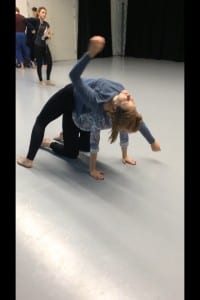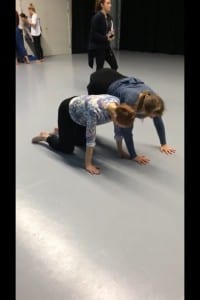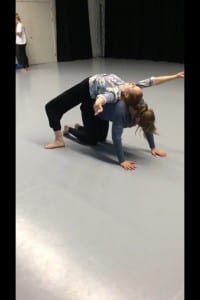To begin our lesson, we compared two contact improvisation films. The first film Steve Paxton’s Magnesium (1972) portrayed a lot of aggressive movement, slamming on the floor and harsh dynamics. This ultimately suggested that both performers were engaging in some sort of battle. The movement in this piece was predominately drew from aikdo and presented a clear notion of unplanned movement material. Unlike the second film we watched, the non pre-set material in Magnesium began with eye contact, as they used eye contact to guide physicality.
The second film we watched was Blake and Brandon’s Earthdance (2010), which presented more fluid and sophisticated movement. It was evident that the performers in this piece had a better understanding of shape and surface. The roles of the over and under dancer were constantly interchanging as the notion of giving and receiving each others weight was presented. In comparison to Magnesium, the performers indicated a lot more awareness of strength when holding each others weight as their movement was much more fluid and the modulation of tone was more sophisticated, which immediately indicated that they had a greater understanding of weight and showed the connection that they had with each other. Furthermore, whilst both performances showed elements of creativity in them, it is evident that contact improvisation has changed slightly over time, as unlike Magnesium, the dancers in Earth Dance seems to be a lot more aware and concious of their decisions as the movement is more fluent but also suggests that now contact improvisation is including more choreographic conventions but not greatly.
We started our lesson by experimenting with the movement of the head, keeping all surfaces of the head in contact with the floor at all times, giving the floor the weight of our head and releasing the tension in the neck and head joints so our movements become more fluid. Usually, I hold quite a lot of tension in my head and neck and find it quite difficult to let the head go and become free. However, this exercise enabled me to think less habitually and use a different part of my body for contact, which I don’t normally use. This exercise was then developed in partners. Firstly, one partner would improvise around the space, whilst the other partner would follow their partner, supporting the back of their head as they travelled. In giving my partner all my weight of my head, I developed a sensation that I don’t usually feel as I allowed my head to become relaxed. This was due to the fact that I had confidence in my partner and I trusted that they were supporting my head efficiently so I didn’t need to worry about letting my head go. When my partner took their hand away from my head, I developed a sense of a heavy head and I was actually unaware that they had taken their hand away, which made me to continue to move in a relaxed way and actually move in an non habitual way. This therefore enabled me to think unconsciously and find different ways of moving with the initiation of my head, which is usually something I neglect when I am participating in contact improvisation. In relation to Steve Paxton’s “Interior Techniques” he states that
‘the body and its reflexes could be free, spontaneous, uninhibited, unfettered, it it were allowed to act without conciousness’s interference…’
Therefore, this unconscious thinking of my own led me to move differently and actually move more creatively.
Afterwards, in our partners we moved around the space, keeping contact with our heads to enforce a physical and an emotional connection. At the beginning of the contact improvisation sessions, I struggled to find different surfaces of my body to initiate movement with but this task helped me to become more experimental with body parts and which different body parts I could initiate movement with. For example, by starting movement with the head it lead into movement that started with body parts, such as the back, elbow and neck instead of starting movement with the hands or feet, which is a habitual nature of my mine.
The last task of our lesson was to use our partners as a base, as we rolled over them, giving them our full body weight. Our partner would start on their knees and gradually become higher as they supported themselves on their hands and knees. Initially, I felt more comfortable being the base as I had confidence in myself to hold my partners weight and I am always concious of giving other people my weight in case I hurt them. However, the exercises that we performed at the beginning of the session with regards to releasing the head and neck, really helped to get rid of my tension and have more confidence on rolling on my partner.
During the lesson, I created a question to individually focus on. How can I experiment with shape and weight without conscious thinking and how can I become more aware of my body when doing so? I believe I had started to experiment with shape a lot more as I have discovered different ways of moving and surfaces of the body to start movement with. However, I feel like I need to experiment with weight further and become more confident in giving others my weight. With reference to how can I experiment with shape? I found that engaging the eyes became effective. According to Daniel Lepkoff, he stated in his interview with Simone Forti (2005) that
‘As an adult we come to rely on tired and true habits. I’ve discovered that when I unhinge myself from my first impulse and read, and re-read and re-read again, where I am, my current physical circumstances, and I take a second, third, fourth, and fifth look, my environment literally transforms itself… it becomes a sensual presence, anything but neutral, and stimulates my imagination.’
In one of the tasks we performed, we had to engage our eyes by looking at one area of the room and moving to that area without consciously thinking about our movement. Therefore, I experimented with shape here because I found myself not thinking about what I was doing and how I was moving, as I had a mindset in my head on where I needed to travel to. Therefore, as I was focused on the place where I needed to go, I didn’t think about movement and this stimulated my imagination and I created something more unique than previously.
Bibliography
Paxton, S. (2010) Steven Paxton’s “Interior Techniques” Contact Improvisation and political power. The Drama Review, 54(3)123-135.
Lepkoff, D. (2008) Contact Improvisation: A Question?. [online] Available fromhttp://www.daniellepkoff.com/Writings/CI%20A%20question.php [Accessed 25 October 2014].


